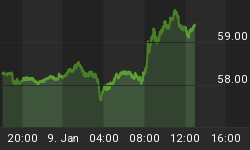Stock markets around the world continue to levitate despite the fact that the fundamentals behind the global economy continue to deteriorate.
U.S. second quarter GDP was significantly revised downward last week from the previously reported 1.7%, to just 1.3%. The paltry 1.3% reading on GDP followed a first quarter print that was already an anemic 2%. Also reported last week was the worsening state of consumer's income. Their take home pay (after taxes and inflation are considered) dropped 0.3% in August, as their savings rate fell to just 3.7%, from 4.1% during the prior month. Another worrisome report showed manufacturing activity in the Chicago region contracted for the first time in three years in the month of September, according to the MNI Chicago Report released on Friday.
But that weak and worsening economic data didn't stop investors from sending stocks higher. The Dow Jones Industrial Average climbed 4.3% and the S&P advanced 5.7% in the third quarter. However, any economic growth to support those moves was seriously lacking. The simple reason behind the ebullient stock market during last quarter was the Fed's persistent threat to soon launch a massive amount of debt monetization. Mr. Bernanke followed through on that threat by announcing an open-ended counterfeiting scheme on September 13th.
Turing to Europe, the situation is much the same. Spanish unemployment has reached 25% and the bank of Spain warned last week that the country is in a "deep recession", which will be its second in the last three years. Also, an audit of Spanish banks indicated that $76.3 billion of capital will be needed for their banks to ride out the next recession and that paved the way for the troubled nation to ask for an international bailout.
However, that negative and deteriorating news didn't stop Spain's IBEX 35 from climbing nearly 30% in the last two months! That's because Mr. Draghi promised to do "whatever it takes" to save the Euro on July 26th, which coincided perfectly with the turnaround in Spanish stocks and the drop in their 10 year note yield from 7.6%, to 5.9%.
Joining the Fed and the ECB's recent efforts to push stock prices higher was the People's Bank of China. The PBOC injected a net $57.9 billion into money markets last week, which was the largest in their history. The market's reaction was swift and profound, sending the Shanghai Composite up nearly 5% in just three trading days. The move higher was achieved despite the fact that manufacturing activity in China during September remained in contractionary territory for the 11th consecutive month and their GDP continues to falter.
The U.S. is headed over the fiscal cliff and into another recession but who cares? Investors can't sit in cash while the Fed is destroying the purchasing power of the dollar. Europe is in recession and its Southern nations are flirting with a depression; but it just doesn't seem to matter. You can't hold bonds when the ECB is rapidly inflating the Euro and is pushing bond real yields further into negative territory in real terms. China's growth rate is plunging and a substantial portion of their economy has been in recession for almost a year. However, it isn't enough to stop shares from turning higher. You can't hoard Renminbi if the PBOC is flooding the banking system with new money at a record pace.
Adding to the money printing mayhem was Chicago Fed President Charles Evans. He is the architect behind QE III, a voting member of the FOMC in 2013 and Bernanke's right-hand man. Mr. Evans hinted on Monday that QE IV is just around the corner--even though the echoes of QE III are still reverberating from Bernanke's lips. QE3's plan is to buy $40 billion of mortgage-backed securities every month and until the unemployment rate magically declines.
But Evans now says that the Fed should continue buying at least $45 billion more of long-term Treasuries and MBS, even after Operation Twist ends in January. However, he did not indicate that these new and additional purchases, which will start in January, would be sterilized.
The $40 billion each month of MBS purchases (QE III) is not sterilized, but the $45 billion in Operation Twist is sterilized. The Fed is currently buying long-term Treasuries and selling government paper that matures in less than 3 years to offset the $45 billion. But the reason why Evans didn't say that these new purchases would be sterilized is because they will not.
The truth is the Fed doesn't have many short-term Treasuries left to sell. Evans said the $45 billion a month should last at least a year. That's $540 billion worth of new central bank purchases of longer-dated Treasuries. However, the Fed cannot sterilize that $540 billion when the Fed's balance sheet shows that they are almost out of short-term Treasuries. So if the plans for QE IV go into effect; it would be an unsterilized, open-ended, double-down version of QE3.
Bernanke is forcing investors out of cash and bonds. Of course, the move into commodities and equities is being done is out of desperation. It is simply an effort to keep ahead of inflation; and in no way represents the hope that real growth will resume anytime soon. In fact, these counterfeiting efforts do serious damage to the economy.
But investors should never fight a central bank that has pledged to do everything in their power to prop up asset prices. A firm commitment from those that control the currency to systematically destroy its value renders investors with no choice but to plow money into precious metals, energy and agriculture.
















